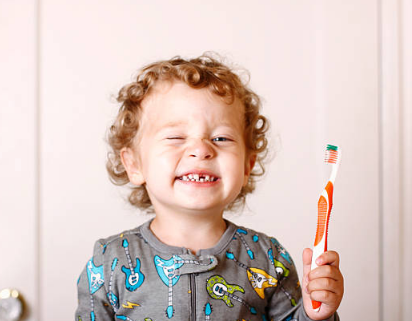Now there’s one thing to laugh about: from 6 months of age, your baby may start to grin! The first teeth to appear are almost always the lower incisors, followed by the upper two. (If you have a toothless old cutie on your hands, don’t worry too much!) It can take up to 12 or 14 months and your baby’s first tooth is about to show out.)
But here’s the thing: you don’t have to wait until your baby has teeth to start prioritizing oral hygiene. In fact, you should wipe your baby’s gums from the start. The sooner you start, the better off the two of you. Here’s everything you need to know about when and how to brush your baby’s teeth, and which toothbrush and toothpaste are best for your baby.
How to Take Care of Your Baby’s Mouth
It’s important to start your baby’s oral care routine before they teeth. After each feeding, gently wipe your baby’s gums with a clean, wet gauze pad or cloth… or at least twice a day, after breastfeeding, with breakfast and before dinner. Be sure to reach under your baby’s lips because germs love to hide there! Also gently wipe your child’s tongue, being careful not to step back too far and trigger the gag reflex. As your baby becomes more engaged, consider using a silicone baby toothbrush. It’s a great way to get your child to “practice” brush their teeth on their own… and get comfortable with this routine.

When to Start Brushing Your Baby’s Teeth
Even though baby teeth start to fall out as early as the age of 6, it’s still very important to take care of your child’s temporary smile. After all, small teeth are just as susceptible to decay and cause pain as older children’s teeth. That’s why the American Academy of Pediatrics recommends brushing your baby’s teeth when their first pearly whites arrive.
At this point, brush your baby’s teeth with a fluoride toothpaste and a toothbrush designed for your baby’s delicate mouth. Since the amount of toothpaste you use is very small (e.g. the size of a grain of rice), it’s okay if your baby accidentally swallows toothpaste. Don’t worry about flossing for the time being, but once the two baby teeth come into contact, you should start flossing them every day (this usually happens around age 2 or 3).
The Best Toothbrush for Babies
Choose a toothbrush with soft bristles, baby-sized, bright colors (or a toothbrush with text on it) to make your oral care more appealing. Toothbrushes designed for babies have a smaller head (for small mouths) and a wider handle to make it easier for little hands to grasp. These toothbrushes are usually labeled with the appropriate age range, so you know you’re using the right toothbrush. By the way, finger silicone brushes don’t clean new teeth very well. It’s best to swap it out for a baby toothbrush with nylon bristles.
The Best Toothpaste for Babies
Studies have shown that it is safe and wise to use fluoride toothpaste when your baby is experiencing their first teeth. Fluoride is a naturally occurring mineral that helps to strengthen the resistance of teeth to decay. While fluoride is often found in tap water, the fluoride in toothpaste is essential for providing extra protection to your teeth. It is important to know that there are many baby toothpastes, but not all of them contain fluoride, which is the recommended option. When buying your child’s toothpaste, read the label… and look for the American Dental Association Seal of Approval. The seal lets you know that the toothpaste is safe, effective, and contains zero flavorings, such as sugar, that can cause tooth decay.

How to Brush Your Baby’s Teeth
Then again, once your child has their first teeth, it’s time to pull out a baby-sized toothbrush. The first time you use a toothbrush with your baby, give them a chance to play with the toothbrush. Let them put it in their mouths to get used to their new “toy”.
When you’re ready to brush your teeth, squeeze a grain of rice-sized amount of fluoride toothpaste onto your child’s soft-bristled toothbrush. (After your child reaches age 3, increase the dosage to the size of a pea.) Every morning and evening, gently brush the front, back and sides of each of your baby’s teeth, gently drawing circles around the teeth and gums. Since you’re only using a small amount of toothpaste, your baby’s won’t need to spit or rinse their mouth after they’re done.
Brush your baby’s teeth and gums twice a day, after breakfast and before bedtime. Keep the pressure low by playing special brushing tunes and/or brushing your teeth at the same time! Shoot about two minutes of brushing time in total, because you know that your child may not be very cooperative at this stage of the oral hygiene game. Do what you can!
Bottom line: Brushing your baby’s teeth takes time and patience, but when these intense habits begin to stick and your child’s chewing function is as healthy as possible, your efforts will pay off.

